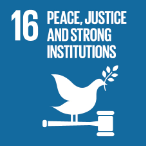SDG16 – Peace, Justice and Strong Institutions

New Vocabulary
- violence
- corruption
- rights
- peace
- conflict
- justice
- court
- insecurity
- respect
- vote
Practice the new vocabulary
Peace, Justice and Strong Institutions Vocabulary Practice (text version)
Match the words to their definitions:
Words:
- insecurity
- violence
- justice
- rights
- court
- vote
- corruption
- peace
- respect
- conflict
Definitions:
- the act of hurting someone physically
- illegal or immoral behavior
- something that you are legally allowed to do
- the act of not fighting
- the act of fighting physically or verbally
- fairness in how people treat you
- the official place where a judge decides whether someone did something illegally or not
- not having the confidence
- looking up to someone as if you want to have the same qualities as them
- to choose someone to represent a group of people
Check your answers in footnote[1]
Activity source: Peace, Justice and Strong Institutions Vocabulary Practice by Virginia McHardy, CC BY-NC 4.0
Peace, Justice and Strong Institutions
According to the United Nations Department of Economic and Social Affairs (n.d.) Goal 16 Infographic:
Goal 16 is about making sure that all people live in safe and fair societies. This means reducing violence, making sure laws protect everyone, and allowing people to have a voice in their community.
Many people in the world live in places with war, crime, and corruption. In these places, people do not feel safe, and their rights are not protected. Violence and unfair treatment make it harder for countries to grow and develop.
- Peace is important for a country to grow. If there is too much conflict, it is hard for people to have jobs, go to school, or live happy lives.
- Justice means that all people, rich or poor, should be treated fairly by the law. Everyone should be able to get help if they are treated unfairly.
- Strong institutions like courts, police, and governments should work fairly and honestly to help people, not harm them.
What happens if we don’t act?
- More violence and insecurity will hurt people, families, and communities.
- Children who grow up in unsafe places may not get an education or a healthy life.
- Corruption (dishonest leaders) can make life worse for people who already struggle.
What can we do?
- Respect others – Treat people from different backgrounds with kindness.
- Speak up – If you see unfair treatment, report it or talk about it.
- Know your rights – Learn about laws and leaders in your community.
- Vote and participate – If possible, support leaders who want peace and fairness.
By working together, we can make the world safer, fairer, and more peaceful for everyone.
Canadian Perspective
Goal 16, Peace, Justice and Strong Institutions (text version)
Promote peaceful and inclusive societies for sustainable development, provide access to justice for all and build effective, accountable and inclusive institutions at all levels
Confidence in Institutions[2] in 2022
Less than 50% of Canadians had confidence in the justice system & courts. This rate was lowest among LGBTQ2+ people at 29%. LGBTQ2+ women had the least confidence at 22%, less than half the confidence of non-LGBTQ2+ women. Almost 32% of non-Indigenous people had confidence in the Canadian media. More than double the rate of Indigenous people.
Cybercrime
Police-reported cybercrime violations[3] reached a rate of 191 per 100,000 population in 2022, more than 3 times higher than in 2015. Fraud accounted for over 36,800 violations in 2022, around half of all cyber-related violations.
Community Spotlight: Wisdom2Action
Wisdom2Action’s mission is to facilitate positive change and strengthen communities through gender justice and 2SLGBTQIA+ inclusion, children’s rights and youth engagement, and mental health and substance use.
Safer Access For Everyone in the Rainbow (SAFER): 3-year project funded by Women and Gender Equality Canada to address and prevent gender-based violence against 2SLGBTQIA+ youth. From February 2022 to March 2023, 327 representatives attended 16 training sessions across Canada and 92% of the trainees reported knowledge gain while 83% reported skills gain. A public education campaign has been implemented and knowledge mobilization symposia are currently underway.
Sources: Statistics Canada, Canadian Social Survey, 2023. Statistics Canada, Uniform Crime Reporting Survey, 2022. Wisdom2Action, 2023.
Source: Goal 16, Peace, Justice and Strong Institutions In Agenda 2030 Sustainable Development Goals Report, 2022 by Statistics Canada, used under Open License
Discussion Questions
Use the new vocabulary words in these discussion questions. Ask and answer in partners or small groups:
- What are some types of violence that you hear about in the news? How do they affect the people involved and their communities?
- What is corruption? Give some examples. Why do you think corruption happens in some countries or organizations? How can we stop it?
- What rights do people have in your country? Why is it important for everyone to know their rights?
- How do you feel when there is peace in a country? What are some things that can help bring peace to a country?
- What causes conflict between people or countries? Can you think of any examples of conflicts from history or the news?
- What does justice mean to you? Can you think of a situation where justice was not done? How was that problem solved?
- What happens in a court? Why is it important for courts to be fair and unbiased?
- How do you feel when you are in an insecure or dangerous situation? What can be done to make people feel safer?
- Why is it important to show respect for people who are different from us? Can you think of ways to show respect in your community?
- What is the importance of voting in an election? Why should everyone have the right to vote? How can voting help bring change in society?
Watch the video:
Watch Goal 16: Peace, Justice and Strong Institutions (1 min) on YouTube
Video source: UNStats. (2022, July 7). Goal 16 – Peace, justice and strong institutions [Video]. YouTube. https://www.youtube.com/watch?v=aXPlRnb6ItQ
Peace, Justice and Strong Institutions Video Quiz (text version)
- True or false? The last time the world had so many wars was in 1946.
- How many people have had to move because of a conflict in their country?
- 10,000
- 1,000,000
- 100,000
- 100,000,000
- Complete the sentence using the words given:
Words: afraid, third, females
Sentence: A [Blank A] of the global population (the majority of [Blank A]) is [Blank A] of walking alone in the evening. - True or false? Crookedness is only happening in 3rd world countries.
- How many businesses do public officials bribe?
- 16%
- 60%
- 6%
Check your answer in footnote[4]
Key Targets for SDG 16
- 16.1 Significantly reduce all forms of violence and related death rates everywhere.
- 16.2 End abuse, exploitation, trafficking and all forms of violence against and torture of children.
- 16.3 Promote the rule of law at the national and international levels and ensure equal access to justice for all.
- 16.4 By 2030, significantly reduce illicit financial and arms flows, strengthen the recovery and return of stolen assets and combat all forms of organized crime.
- 16.5 Substantially reduce corruption and bribery in all their forms.
- 16.6 Develop effective, accountable and transparent institutions at all levels.
- 16.7 Ensure responsive, inclusive, participatory and representative decision-making at all levels.
- 16.8 Broaden and strengthen the participation of developing countries in the institutions of global governance.
- 16.9 By 2030, provide legal identity for all, including birth registration.
- 16.10 Ensure public access to information and protect fundamental freedoms, in accordance with national legislation and international agreements.
- 16.a Strengthen relevant national institutions, including through international cooperation, for building capacity at all levels, in particular in developing countries, to prevent violence and combat terrorism and crime.
- 16.b Promote and enforce non-discriminatory laws and policies for sustainable development.
Source: United Nations Department of Economic and Social Affairs. (n.d.). Goal 16 [Infographic]. Sustainable Development Goals. https://sdgs.un.org/goals/goal16

Homework/Assignment:
1. Mock Courtroom Role Play
- In a small group, create a simple courtroom scenario (example: someone is accused of stealing, and a judge must decide).
- Assign roles (judge, lawyer, accused person, witness, jury) and act it out.
- Discuss: Was the trial fair? How did the judge make the decision?
2. Letter to a Leader
- Write a letter to a local government leader about an issue related to peace or justice in your community.
- Suggest a solution and explain why it matters.
- (Optional) Send the letter and see if you receive a response!
You can read more about Goal #16 in The Sustainable Development Goals Report 2022 from the UN.:
For instructors, please visit York University’s The SDGs-in-the-Classroom Toolkit for lesson ideas
Attribution & References
Except where otherwise noted, this page is created by Virginia McHardy, CC BY-NC 4.0
References
United Nations Department of Economic and Social Affairs. (n.d.). Goal 16 [Infographic]. Sustainable Development Goals. https://sdgs.un.org/goals/goal16
- 1. violence, 2. corruption, 3. rights, 4. peace, 5. conflict, 6. justice, 7. court, 8. insecurity, 9. respect, 10. vote ↵
- Confidence in institutions is measured on a scale from 1 to 5 and a rating of 4 or 5 is used to represent respondents that have confidence in the institution. Respondents were asked, “Using a scale of 1 to 5 where 1 means ‘No confidence at all’ and 5 means ‘A great deal of confidence’ how much confidence do you have in the institution? Data are from the fourth quarter of 2022 and exclude the territories. ↵
- To make comparisons over time, cybercrime trend information includes only those police services who have consistently reported data for the entire period. For the years 2015 to 2022, the data exclude the Canadian Forces Military Police, the municipal police service of Calgary, the Ontario Provincial Police, the Quebec City Police, and the Saint John Police Force. ↵
- 1. True. 2. d. 3. a) third, b) females, c) afraid. 4. False. 5. c. ↵
behavior that is intended to hurt someone physically
illegal or immoral behavior
something that you are morally, legally, or officially allowed to do or have
the act of not fighting
war; the act of fighting physically or verbally
fairness in how people treat you
the official place where a judge decides whether someone did something illegally or not
not having the confidence
looking up to someone as if you want to have the same qualities as them
to choose someone to represent a group of people

